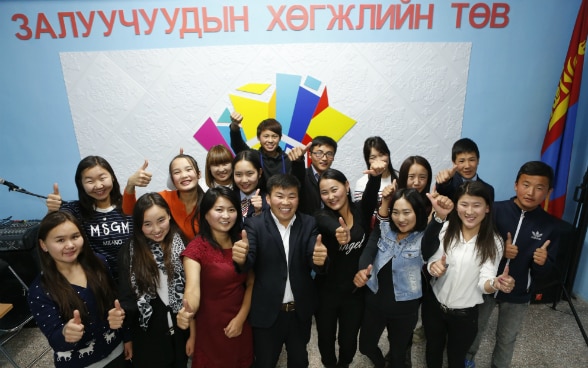
“Since the establishment of the YDC in our city, my friends and colleagues often hang out here because it’s nearby our school and is a convenient place for us to productively spend our free time,” said L. Mukhtsooj, 20, a regular client at the Khovd YDC. “The staff here are also very welcoming to us.”
There are 15 YDCs throughout Mongolia, and each provides youth with a range of programmes aimed at building their life skills, providing knowledge about their rights and responsibilities, and offering them meaningful ways to realise their potential. These multi-purpose centres also offer a range of skills-development services, such as career planning and healthy leisure activities.
“There are many clubs that bring together youth based on their interests and hobbies. We have clubs for amateur photographers and book lovers, and a girls’ group with arts and fashion, to name but a few,” said Enkhbayar, coordinator of the Khovd YDC.
The YDCs are fun, safe places for young people to spend their free time and develop their social skills. The centres also target marginalised youth and young families, providing them with life skills education and other trainings.
“We try to offer comprehensive and holistic services for our clients,” said S. Khishigtogtokh, a social worker at the Khovd YDC. “There are support groups addressing vulnerable youth, such as youth in prisons or those with disabilities.
In assisting young families, Khishigtogtokh said: “We try our best to reach every family member, providing counselling for young people and young couples, supporting their children in their school enrolment, and addressing their health and livelihoods, jointly with other public services”.
Mr O. Battur, 28, a local auto mechanic, his wife Tsetsegjargal, 26, and their four children have benefited from the services offered by the Khovd YDC. The couple attended family and relationships workshops - the first such training in which they had taken part. “I learned a great deal about family relations and parenting,” Battur said. “It’s been an interesting training for a man like me who knew nothing other than fixing cars.”
His wife Tsetsegjargal also attended a skills-development training organised by the Khovd YDC and became a certified kindergarten assistant. And while finding a job in such a remote town is a challenge, she is nonetheless positive about the future. “My dreams are now brighter. I want all my kids to finish school and be well-educated. I want to build a happy family,” she said.


